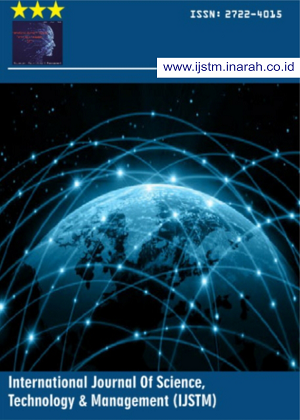Analysis of Rewards and Punishment on the Performance of State-Owned Enterprise Employees in Medan Region
Abstract
Motivating workers through the use of rewards and punishments, the management control system places an emphasis on output. Any decent employee will follow the rules set out by their employer and will push for their coworkers to do the same. Finding out whether company rewards and punishments have an effect on employee performance in a State-Owned Enterprise is the main objective of this study. Quantitative studies employ non-probability purposive sampling and associative causality studies. With the aid of SmartPLS, descriptive statistics were applied to 100 questionnaires. All of the study's variables were found to have a positive and statistically significant effect. With a t-statistic value of 4.218, employees believe that the company's performance reviews can positively affect their pay, benefits, and advancement opportunities. The company's punisment motivate employees to perform well in order to avoid pay cuts and promotion delays (t-statistic value 4.861). When workers' expectations regarding company assessments and reward are satisfied, their performance improves (t-statistic value 3.900). Therefore, it is reasonable to assume that, with proper implementation of evaluation and sanctions, staff performance will improve. While punishments are the most powerful incentive for improving performance, this study's original finding is that positive reinforcement in the form of awards can inspire loyalty and good conduct.
Downloads
References
Undang-Undang RI, “Undang-Undang Republik Indonesia No.19 Tahun 2003 Tentang Badan Usaha Milik Negara,” 2003.
AirNav, Pedoman Good Corporate Governance AirNav Indonesia. Tangerang: Perum LPPNPI, 2014. [Online]. Available: https://idx.co.id/tentang-bei/tata-kelola-perusahaan/
A. Dachner, J. E. Ellingson, R. A. Noe, and B. Saxton, “The Future Of Employee Development,” Human Resource Management Review, vol. 31, no. 2, pp. 1–16, 2021, doi: 10.1016/j.hrmr.2019.100732.
L. B. P. da Silva et al., “Human Resources Management 4.0: Literature Review and Trends,” Comput Ind Eng, vol. 168, no. March, pp. 1–20, 2022, doi: 10.1016/j.cie.2022.108111.
A. Kimwolo and T. Cheruiyot, “Intrinsically motivating idiosyncratic deals and innovative work behaviour,” vol. 11, no. 1, pp. 31–47, 2019, doi: 10.1108/IJIS-05-2017-0038.
D. Balliet, L. B. Mulder, and P. A. M. Van Lange, “Reward, punishment, and cooperation: A meta-analysis,” Psychol Bull, vol. 137, no. 4, pp. 594–615, 2011, doi: 10.1037/a0023489.
N. Patria, “Pengaruh Sistem Reward Terhadap Hubungan Antara Total Quality Management (TQM) Dengan Kinerja Manajerial (Pada Perusahaan BUMN yang Bergerak di Bidang Asuransi Kota Jambi),” JISMA: Jurnal Ilmu Sosial, Manajemen, dan Akuntansi, vol. 1, no. 3, pp. 133–140, 2022.
F. Anwar and E. P. Nainggolan, “Moderasi Reward Pada Pengaruh Sistem Akuntansi Manajemen Dan Pengukuran Kinerja Terhadap Kinerja Manajerial (Studi Kasus Perusahaan Bumn Di Kota Medan),” Journal of Economic, Bussines and Accounting (COSTING), vol. 7, no. 1, pp. 1140–1151, 2023, doi: 10.31539/costing.v7i1.7275.
S. R. N. Marpaung, A. Hizazi, and Wiralestari, “Pengaruh total quality management terhadap kinerja manajerial dengan sistem pengukuran kinerja dan sistem penghargaan (reward) sebagai variabel intervening (studi empiris pada perusahaan BUMN di Kota Jambi),” Jurnal Paradigma Ekonomika, vol. 17, no. 1, pp. 137–148, 2022, doi: 10.22437/jpe.v17i1.16327.
I. Sidik, H. AR, M. Gunarto, and S. Helmi, “Pengaruh Reward dan Punishment terhadap Kinerja Karyawan dengan Motivasi Kerja sebagai Variabel Intervening di Badan Usaha Milik Negara (Studi Kasus: PT. Semen Baturaja, Tbk),” J-MAS (Jurnal Manajemen dan Sains), vol. 8, no. 2, p. 1987, 2023, doi: 10.33087/jmas.v8i2.1110.
R. D. V. Priharti, T. Herlina, and R. Violita, “Pengaruh Pemberian Reward, Punishment Dan Kerjasama Tim Terhadap Kinerja Pegawai PT. Kereta Api Indonesia (Persero) Divre IV Tanjung Karang,” Jurnal Ekonomika, vol. 15, no. 2, pp. 131–280, 2022.
A. A. A. P. Mangkunegara, Manajemen Sumber Daya Manusia Perusahaan, Edisi 14. Bandung: Remaja RosdaKarya, 2017.
B. Suwarno, Studi Kelayakan Bisnis-Tujuan Studi Kelayakan Bisnis, Edisi 1. Medan: Andalan Bintang Ghonim, 2020.
M. S. P. Hasibuan, Manajemen Sumber Daya Manusia (Edisi Revisi). Jakarta: Bumi Aksara, 2021.
F. Liu, K. Tso, Y. Yang, and J. Guan, “Multilevel Analysis of Employee Satisfaction on Commitment to Organizational Culture: Case Study of Chinese State-Owned Enterprises,” Mathematical and Computational Applications, vol. 22, no. 4, p. 46, 2017, doi: 10.3390/mca22040046.
Dr. N. H. Tien, “Working environment and labor efficiency of state-owned enterprises and foreign corporations in Vietnam,” International Journal of Research in Human Resource Management, vol. 1, no. 1, pp. 31–34, 2019, doi: 10.33545/26633213.2019.v1.i1a.9.
C. Anwar, M. Basyir, and S. Armia, “Factors affecting the involvement of employees in State owned enterprises (SOEs) in Aceh Province,” International Journal of Management …, vol. 8, no. 2, pp. 139–149, 2017.
Sedarmayanti, Manajemen Sumber Daya Manusia : Reformasi Birokrasi Dan Manajemen Pegawai Negeri Sipil (Edisi Revisi), 9th ed. Bandung: Refika Aditama, 2017.
S. P. Robbins and T. A. Judge, Organizational Behavior, 16th ed. Harlow Essex, UK: Pearson Education Limited, 2022. doi: 10.4324/9781003009580-20.
I. Fahmi, Manajemen Sumber Daya Manusia: Teori dan Aplikasi, 3rd ed. Bandung: Alfabeta, 2022.
Z. V. Rivai, M. Ramly, T. Mutis, and W. Arafah, Manajemen Sumber Daya Manusia untuk Perusahaan: Dari Teori ke Praktik, 3rd ed. Jakarta: RajaGrafindo Persada, 2015.
Sugiyono, Metodologi Penelitian Kuantitatif, Kualitatif dan R & D, 2nd ed. Bandung: Alfabeta, 2020.
J. F. Hair, G. T. M. Hult, C. M. Ringle, M. Sarstedt, N. P. Danks, and S. Ray, Partial Least Squares Structural Equation Modeling (PLS-SEM) Using R, Classroom. Switzerland: Springer International Publishing, 2021.
I. Ghozali, Model Persamaan Struktural Partial Least Squares (PLS) : Aplikasi Dengan Program R Paket plspm, semPls dan seminR. Semarang: Yoga Pratama, 2021.
V. Rivai, M. Ramly, T. Mutis, and W. Arafah, Manajemen Sumber Daya Manusia, 8th ed. Jakarta: RajaGrafindo Persada, 2018.
Copyright (c) 2025 International Journal of Science, Technology & Management

This work is licensed under a Creative Commons Attribution-ShareAlike 4.0 International License.
































